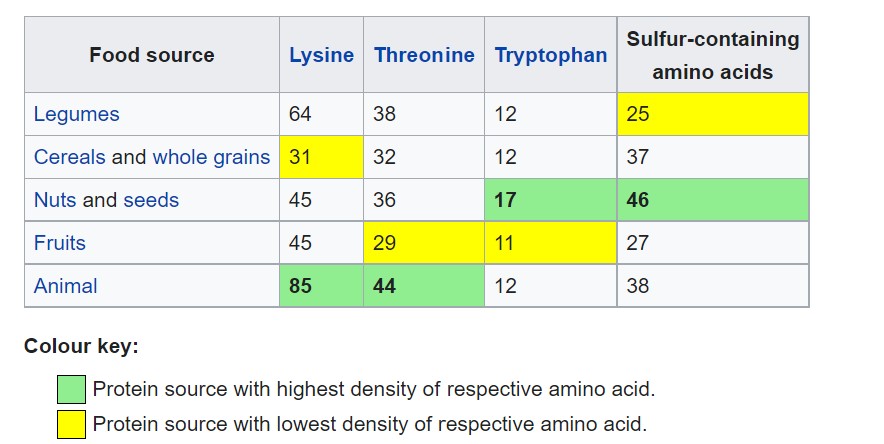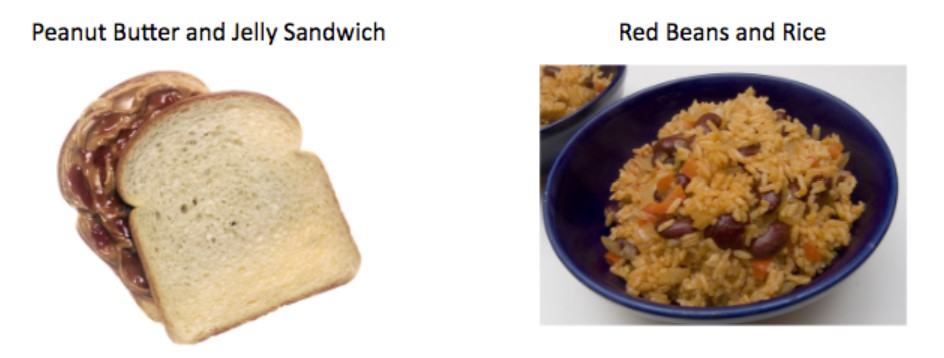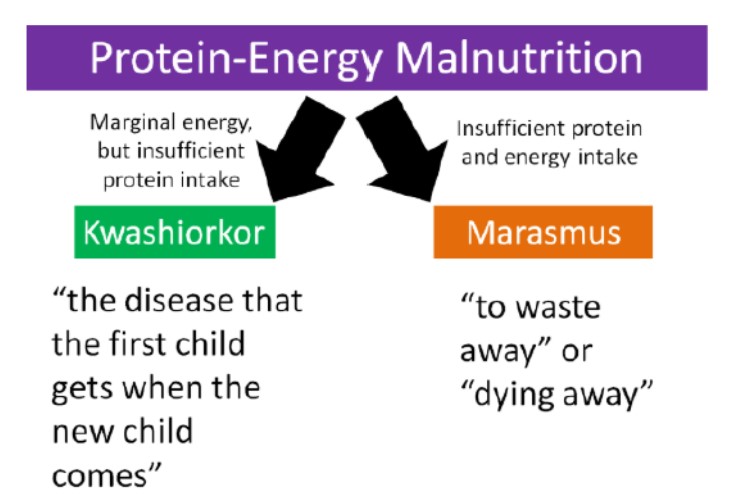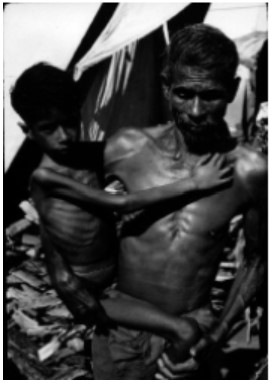1.4.3: Proteins- Muscle and Much More
- Last updated
- Save as PDF
- Page ID
- 225659
Learning Objectives
- Describe the metabolism of proteins.
- Know the importance of essential amino acids.
- Know the sources and function of common proteins in the diet.
Proteins are essential nutrients for the human body. They are one of the building blocks of body tissue and can also serve as a fuel source. As a fuel, proteins provide as much energy density as carbohydrates: 4 kcal (17 kJ) per gram; in contrast, lipids provide 9 kcal (37 kJ) per gram. The most important aspect and defining characteristic of protein from a nutritional standpoint is its amino acid composition.
Proteins are polymer chains made of amino acids linked together by peptide bonds. During human digestion, proteins are broken down in the stomach to smaller polypeptide chains via hydrochloric acid and protease actions. This is crucial for the absorption of the essential amino acids that cannot be biosynthesized by the body.
Protein Functions in Human Body
Protein is a nutrient needed by the human body for growth and maintenance. Aside from water, proteins are the most abundant kind of molecules in the body. Protein can be found in all cells of the body and is the major structural component of all cells in the body, especially muscle. This also includes body organs, hair and skin. Proteins are also used in membranes, such as glycoproteins. When broken down into amino acids, they are used as precursors to nucleic acid, co-enzymes, hormones, immune response, cellular repair, and other molecules essential for life. Additionally, protein is needed to form blood cells.
Protein Metabolism: Essential Amino Acids
Protein digestion begins in the stomach (Figure \(\PageIndex{3}\)), where the action of gastric juice hydrolyzes about 10% of the peptide bonds. Gastric juice is a mixture of water (more than 99%), inorganic ions, hydrochloric acid, and various enzymes and other proteins.
The pain of a gastric ulcer is at least partially due to irritation of the ulcerated tissue by acidic gastric juice.

The hydrochloric acid (HCl) in gastric juice is secreted by glands in the stomach lining. The pH of freshly secreted gastric juice is about 1.0, but the contents of the stomach may raise the pH to between 1.5 and 2.5. HCl helps to denature food proteins; that is, it unfolds the protein molecules to expose their chains to more efficient enzyme action. The principal digestive component of gastric juice is pepsinogen, an inactive enzyme produced in cells located in the stomach wall. When food enters the stomach after a period of fasting, pepsinogen is converted to its active form—pepsin—in a series of steps initiated by the drop in pH. Pepsin catalyzes the hydrolysis of peptide linkages within protein molecules. It has a fairly broad specificity but acts preferentially on linkages involving the aromatic amino acids tryptophan, tyrosine, and phenylalanine, as well as methionine and leucine.
Protein digestion is completed in the small intestine.
Amino Acids
There are 20 amino acids our body uses to synthesize proteins. These amino acids can be classified as essential, non-essential, or conditionally essential. The table below shows how the 20 amino acids are classified.
| Essential | Conditionally Essential | Non-essential |
|---|---|---|
| Histidine | Arginine | Alanine |
| Isoleucine | Cysteine | Asparagine |
| Leucine | Glutamine | Aspartic Acid or Aspartate |
| Lysine | Glycine | Glutamic Acid or Glutamate |
| Methionine | Proline | Serine |
| Phenylalanine | Tyrosone | |
| Theronine | ||
| Tryptophan | ||
| Valine |
The body cannot synthesize nine amino acids. Thus, it is essential that these are consumed in the diet. As a result these amino acids are known as essential, or indispensable, amino acids.
Non-essential, or dispensable, amino acids can be made in our body, so we do not need to consume them. Conditionally essential amino acids become essential for individuals in certain situations. An example of a condition when an amino acid becomes essential is the disease phenylketonuria (PKU). Individuals with PKU have a mutation in the enzyme phenylalanine hydroxylase, which normally adds an alcohol group (OH) to the amino acid phenylalanine to form tyrosine as shown below.

Since tyrosine cannot be synthesized by people with PKU, it becomes essential for them. Thus, tyrosine is a conditionally essential amino acid. Individuals with PKU have to eat a very low protein diet and avoid the alternative sweetener aspartame, because it can be broken down to phenylalanine. If individuals with PKU consume too much phenylalanine, phenylalanine and its metabolites, can build up and cause brain damage and severe mental retardation. The drug Kuvan was approved for use with PKU patients in 2007 who have low phenylalanine hydroxylase activity levels.
Protein Sources
Protein occurs in a wide range of food. On a worldwide basis, plant protein foods contribute over 60% of the per capita supply of protein. In North America, animal-derived foods contribute about 70% of protein sources. Insects are a source of protein in many parts of the world. In parts of Africa, up to 50% of dietary protein derives from insects. It is estimated that more than 2 billion people eat insects daily.
Meat, dairy, eggs, soy, fish, whole grains, and cereals are sources of protein. Examples of food staples and cereal sources of protein, each with a concentration greater than 7%, are (in no particular order) buckwheat, oats, rye, millet, maize (corn), rice, wheat, sorghum, amaranth, and quinoa. Some research highlights game meat as a protein source.

Vegan sources of proteins include legumes, nuts, seeds and fruits. Vegan foods with protein concentrations greater than 7% include soybeans, lentils, kidney beans, white beans, mung beans, chickpeas, cowpeas, lima beans, pigeon peas, lupines, wing beans, almonds, Brazil nuts, cashews, pecans, walnuts, cotton seeds, pumpkin seeds, hemp seeds, sesame seeds, and sunflower seeds.
People eating a balanced diet do not need protein supplements.
The table below presents food groups as protein sources.
Table \(\PageIndex{2}\) Density of amino acid in various protein sources.

Protein powders - such as casein, whey, egg, rice, soy, and cricket flour - are processed and manufactured sources of protein.
Complete and Incomplete Proteins
Proteins can be classified as either complete or incomplete. Complete proteins provide adequate amounts of all nine essential amino acids. Animal proteins such as meat, fish, milk, and eggs are good examples of complete proteins. Incomplete proteins do not contain adequate amounts of one or more of the essential amino acids. For example, if a protein doesn't provide enough of the essential amino acid leucine it would be considered incomplete. Leucine would be referred to as the limiting amino acid, because there is not enough of it for the protein to be complete. Most plant foods are incomplete proteins, with a few exceptions such as soy. The table below shows the limiting amino acids in some plant foods.
| Food | Amino Acid(s) |
|---|---|
| Beans and Most Legumes | Methionine, Tryptophan |
| Tree Nuts and Seeds | Methionine, Lysine |
| Grains | Lysine |
| Vegetables | Methionine, Lysine |
Complementary Proteins
Even though most plant foods do not contain complete proteins, it does not mean that they should be sworn off as protein sources. It is possible to pair foods containing incomplete proteins with different limiting amino acids to provide adequate amounts of the essential amino acids. These two proteins are called complementary proteins, because they supply the amino acid(s) missing in the other protein. A simple analogy would be that of a 4 piece puzzle. If one person has 2 pieces of a puzzle, and another person has 2 remaining pieces, neither of them have a complete puzzle. But when they are combined, the two individuals create a complete puzzle.

(Figure \(\PageIndex{4}\)) Complementary proteins are kind of like puzzle pieces.
Two examples of complementary proteins are shown below.

It should be noted that complementary proteins do not need to be consumed at the same time or meal. It is currently recommended that essential amino acids be met on a daily basis, meaning that if a grain is consumed at one meal, a legume could be consumed at a later meal, and the proteins would still complement one another4.
Measures of Protein Quality
How do you know the quality of the protein in the foods you consume? The protein quality of most foods has been determined by one of the methods below.
- Biological Value (BV) - (grams of nitrogen retained / grams of nitrogen absorbed) x 100
- Protein Efficiency Ratio (PER) - (grams of weight gained / grams of protein consumed)
This method is commonly performed in growing rats.
- Chemical or Amino Acid Score (AAS) - (Test food limiting essential amino acid (mg/g protein) / needs of same essential amino acid (mg/g protein))
- Protein Digestibility Corrected Amino Acid Score (PDCAAS) - (Amino Acid Score x Digestibility)
This is the most widely used method and was preferred by the Food and Agriculture Organization and World Health Organization (WHO) until recently5,6. The following table shows the protein quality measures for some common foods.
| Protein | PER | Digestibility | AA(%) | PDCAAS |
|---|---|---|---|---|
| Egg | 3.8 | 98 | 121 | 100* |
| Milk | 3.1 | 95 | 127 | 100* |
| Beef | 2.9 | 98 | 94 | 92 |
| Soy | 2.1 | 95 | 96 | 91 |
| Wheat | 1.5 | 91 | 47 | 42 |
*PDCAAS scores are truncated (cut off) at 100. These egg and milk scores are actually 118 and 121 respectively.
The Food and Agricultural Organization (FAO) recently recommended that PDCAAS be replaced with a new measure of protein quality, the Digestible Indispensable Amino Acid Score (DIAAS). “DIAAS is defined as: DIAAS % = 100 x [(mg of digestible dietary indispensable amino acid in 1 g of the dietary protein) / (mg of the same dietary indispensable amino acid in 1g of the reference protein)].” Ileal digestibility should be utilized to determine the digestibility in DIAAS; ideally in humans, but if not possible in growing pigs or rats6.
The main differences between DIAAS and PDCAAS are:
- DIAAS take into account individual amino acids digestibility rather than protein digestibility.
- It focus on ileal instead of fecal (total) digestibility.
- Has three different reference patterns (different age groups, 0-6 months, 6 months- 3 years, 3-10 years old) instead of a single pattern
- DIAAS scores will not be truncated7
Protein Deficiency in Young and Old
Protein deficiency rarely occurs alone. Instead it is often coupled with insufficient energy intake. As a result, the condition is called protein-energy malnutrition (PEM). This condition is not common in the U.S., but is more prevalent in less developed countries. Kwashiorkor and marasmus are the two forms of protein energy malnutrition. They differ in the severity of energy deficiency as shown in the figure below.

Kwashiorkor is a Ghanaian word that means "the disease that the first child gets when the new child comes39." The characteristic symptom of kwashiorkor is a swollen abdomen. Energy intake could be adequate, but protein consumption is too low.
Figure \(\PageIndex{7}\): A child suffering from kwashiorkor
Marasmus means "to waste away" or "dying away", and thus occurs in individuals who have inadequate protein and energy intakes.

Summary
- Protein digestion begins in the stomach where hydrolysis of the protein linkages occurs with the action of gastric juices (mainly HCl ) and the active enzyme pepsin. Protein digestion is completed in the small intestine wherein other protein digesting enzymes are involved.
- Essential amino acids cannot be made by the body and must come from food.
- Complete proteins provide adequate amounts of all nine essential amino acids.
- Complementary proteins are made up of two proteins wherein one protein supply the amino acid(s) missing in the other protein.
- Kwashiorkor and marasmus are two forms of protein energy malnutrition that are not common in the U.S., but is more prevalent in less developed countries
Contributors and Attributions
- Template:ContribLindshield
- Libretext: Basics of GOB Chemistry (Ball et al.)
- Wikipedia


